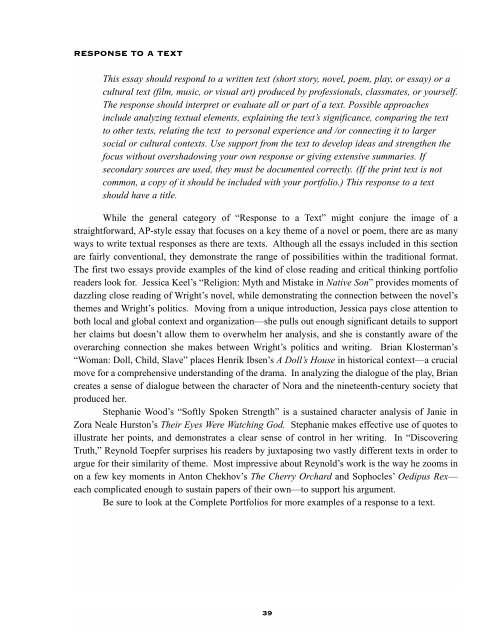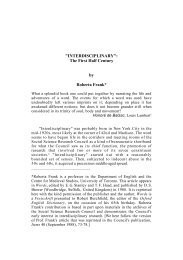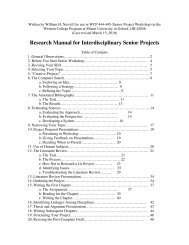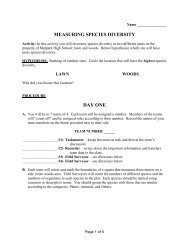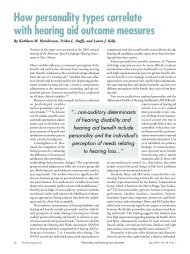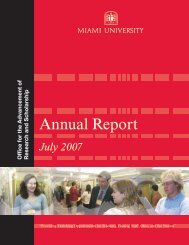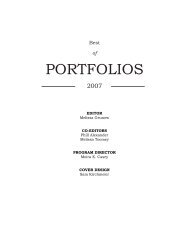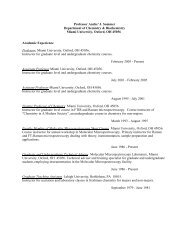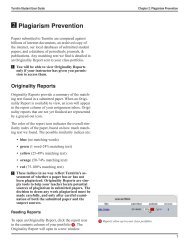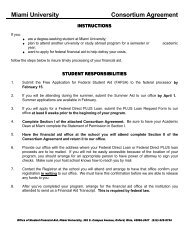Best of Miami Portfolios 2001 - Units.muohio.edu
Best of Miami Portfolios 2001 - Units.muohio.edu
Best of Miami Portfolios 2001 - Units.muohio.edu
You also want an ePaper? Increase the reach of your titles
YUMPU automatically turns print PDFs into web optimized ePapers that Google loves.
RESPONSE TO A TEXT<br />
This essay should respond to a written text (short story, novel, poem, play, or essay) or a<br />
cultural text (film, music, or visual art) produced by pr<strong>of</strong>essionals, classmates, or yourself.<br />
The response should interpret or evaluate all or part <strong>of</strong> a text. Possible approaches<br />
include analyzing textual elements, explaining the text’s significance, comparing the text<br />
to other texts, relating the text to personal experience and /or connecting it to larger<br />
social or cultural contexts. Use support from the text to develop ideas and strengthen the<br />
focus without overshadowing your own response or giving extensive summaries. If<br />
secondary sources are used, they must be documented correctly. (If the print text is not<br />
common, a copy <strong>of</strong> it should be included with your portfolio.) This response to a text<br />
should have a title.<br />
While the general category <strong>of</strong> “Response to a Text” might conjure the image <strong>of</strong> a<br />
straightforward, AP-style essay that focuses on a key theme <strong>of</strong> a novel or poem, there are as many<br />
ways to write textual responses as there are texts. Although all the essays included in this section<br />
are fairly conventional, they demonstrate the range <strong>of</strong> possibilities within the traditional format.<br />
The first two essays provide examples <strong>of</strong> the kind <strong>of</strong> close reading and critical thinking portfolio<br />
readers look for. Jessica Keel’s “Religion: Myth and Mistake in Native Son” provides moments <strong>of</strong><br />
dazzling close reading <strong>of</strong> Wright’s novel, while demonstrating the connection between the novel’s<br />
themes and Wright’s politics. Moving from a unique introduction, Jessica pays close attention to<br />
both local and global context and organization—she pulls out enough significant details to support<br />
her claims but doesn’t allow them to overwhelm her analysis, and she is constantly aware <strong>of</strong> the<br />
overarching connection she makes between Wright’s politics and writing. Brian Klosterman’s<br />
“Woman: Doll, Child, Slave” places Henrik Ibsen’s ADoll’s House in historical context—a crucial<br />
move for a comprehensive understanding <strong>of</strong> the drama. In analyzing the dialogue <strong>of</strong> the play, Brian<br />
creates a sense <strong>of</strong> dialogue between the character <strong>of</strong> Nora and the nineteenth-century society that<br />
produced her.<br />
Stephanie Wood’s “S<strong>of</strong>tly Spoken Strength” is a sustained character analysis <strong>of</strong> Janie in<br />
Zora Neale Hurston’s Their Eyes Were Watching God. Stephanie makes effective use <strong>of</strong> quotes to<br />
illustrate her points, and demonstrates a clear sense <strong>of</strong> control in her writing. In “Discovering<br />
Truth,” Reynold Toepfer surprises his readers by juxtaposing two vastly different texts in order to<br />
argue for their similarity <strong>of</strong> theme. Most impressive about Reynold’s work is the way he zooms in<br />
on a few key moments in Anton Chekhov’s The Cherry Orchard and Sophocles’ Oedipus Rex—<br />
each complicated enough to sustain papers <strong>of</strong> their own—to support his argument.<br />
Be sure to look at the Complete <strong>Portfolios</strong> for more examples <strong>of</strong> a response to a text.<br />
39


